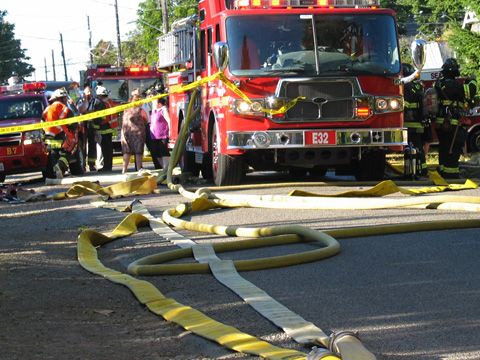
(Saturday photo by Katie Meyer)
By Tracy Record
West Seattle Blog editor
The slack hoses told the story early on at Saturday evening’s house fire in Arbor Heights.
But what was really the problem that led to an inadequate water supply/pressure for firefighters, and forced them to run hoses to relatively distant hydrants?

(Saturday photo by Tony Bradley)
(You can see some of the effects in this bystander video we just found.) A spokesperson for Seattle Public Utilities, which is accountable for the hydrants, tells WSB that SPU and the Seattle Fire Department plan an “after-action review” of the incident.
That’s part of what emerged in our follow-up conversation this afternoon with SPU’s Andy Ryan.
First – for those in the area worried about other possible hydrant problems, Ryan said SPU crews checked Saturday night not only the two hydrants that were apparently having trouble early on in the fire, but also others in the area, and found no problems. He says SPU believes the nearest hydrants were actually working – but maybe something “upstream” was keeping adequate water from reaching the hookup.
The “after-action review” will examine “possible system and possible human contributions to the inability to get water onto the fire,” Ryan said. “It’s too early to tell which … factors were to blame.”
Also over a time frame that Ryan described as “the next couple of weeks,” he said SPU will “look at the overall water pressure in that area – some areas have less water pressure than others.” The water mains’ size could be an issue too, he said. (WSB commenters have discussed a belief the area has smaller mains, but we haven’t been able to find a map we remember was on the city website a few years ago showing the size and age of water pipes.)
Ryan did not have immediate access to the answer to our question about when the two hydrants near the fire scene were last inspected. He contended that overall, “Seattle arguably has the best fire-hydrant inspection program in Western Washington, and the best repair rate.” SFD checks each hydrant at least once a year, “to become familiar with the peculiarities of individual hydrants.” He says SPU then gets a report from SFD if anything is found amiss – even grass growing around the hydrant, or, “we’ve had service orders for dog droppings” around the hydrants.
Bottom line, according to Ryan, is that it is “premature” to blame the water problems on the hydrants. As Fire Chief Gregory Dean had explained on Saturday night, SFD has backup plans/procedures for firefighters to keep going until they find a reliable supply.

(Saturday photo by Katie Meyer)
The initial situation was made worse by the fact that while fire engines carry 500 gallons of water as a backup supply, a ladder truck – which doesn’t carry water – was first to arrive, because two engines were out on a medic call. The closest fire station to Arbor Heights is 37 in Sunrise Heights, and Engine 37 was with Engine 11 (from Highland Park) trying to save an injured child in High Point (look for the 30th SW call on the archived 911 log).
The issue of Arbor Heights fire-response time has come up in recent discussions about White Center (etc.) annexation; even City Council President Richard Conlin wrote earlier this year that if WC/North Highline was part of Seattle, “Arbor Heights will get better fire service from the North Highline fire station than it currently gets from our Seattle fire station.” Right now, though, Burien is moving to explore annexation instead, while Seattle has shelved its possible further consideration till early next year.
We’ll continue to follow up. Meantime, a reminder that Arbor Heights Community Church, which is close to the burned home, has organized a donation drive to help the family who lost their home and belongings (as well as two turtles, though other pets were rescued/found). We published information about it in this story last night. We are also reminded that in addition to the church office hours 10 am-2 pm through Thursday, there is a long-scheduled crime-prevention meeting at the church tomorrow (Tuesday) night at 7 pm, and church member/volunteer Jerri Anne Forehand, who’s spearheading the drive, says donations will be accepted during that event as well .

| 37 COMMENTS